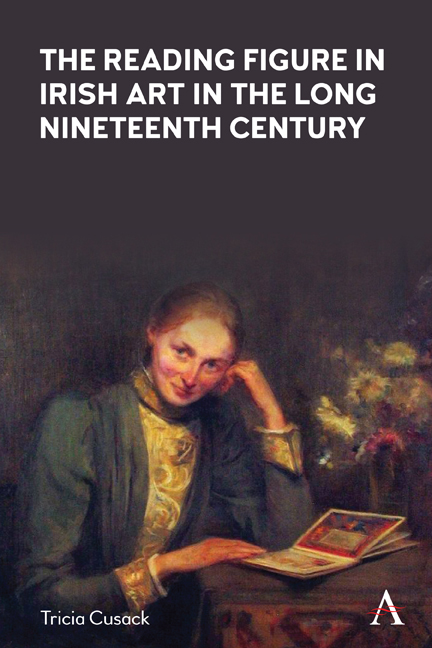Book contents
- Frontmatter
- Contents
- List of Figures
- Acknowledgements
- Introduction
- 1 Imperial Man, Manly Nationalism and the Unmanly Reader
- 2 ‘Creatures of a Different Breed’: Women Readers and Patriarchal Discourse
- 3 The Shaping of the New Woman in Ireland
- 4 The Silent Reader and the Fictive Viewer
- 5 A Room of Her Own: Four New Women in Dublin
- Conclusion
- Notes
- Works Referenced
- Index
- Frontmatter
- Contents
- List of Figures
- Acknowledgements
- Introduction
- 1 Imperial Man, Manly Nationalism and the Unmanly Reader
- 2 ‘Creatures of a Different Breed’: Women Readers and Patriarchal Discourse
- 3 The Shaping of the New Woman in Ireland
- 4 The Silent Reader and the Fictive Viewer
- 5 A Room of Her Own: Four New Women in Dublin
- Conclusion
- Notes
- Works Referenced
- Index
Summary
In summary, this volume has examined an intriguing and distinctive group of Irish portraits of reading figures from the long nineteenth century, mostly depicting female figures and mainly by women artists. The many images of women readers found in European art at this time, generally by male artists, emphasise women's bodily appearance for an admiring viewer, rather than the act of reading. The Irish portraits, by contrast, present a woman engaged in independent solitary reading, while the fictive viewer is excluded, although drawn in, or briefly interrupts her occupation.
Women were legally and politically marginalised in Ireland's patriarchal political and social system, and they were undermined by widespread ideological constructions of them as weak, irrational and dependent. The Catholic Church in particular at this time promoted an exclusively maternal vision of women's lives. However, some women and men in Ireland participated in transnational movements demanding women's suffrage and access to higher education. Early campaigners for women's rights recognised the necessary link between women's social and political advancement and reading. Campaigning and reading both became features of the nascent New Woman in Ireland, alongside a burgeoning of art and literature. Stories and novels included New Women as protagonists, while portrayals of independent women readers created an original visual imagery for the New Woman in Ireland.
Contemporary Irish portraits of men rarely show them reading. The patriarchal society prevalent in Europe, but with its peculiar formations in Ireland, promoted ideals of manliness that discouraged reading for pleasure. In Ireland the landowning Anglo-Irish patriarchy held a British imperial ideal of manliness that postulated an aggressive and naturally hegemonic masculine nature. Their culture, fostered by public school team games and burnished with ancient epics, revolved around sport, politics and the military. Such manliness was based on decisive action, with little value placed on reflective activities such as reading, especially fiction. When a male figure is portrayed with a book, such as a Bible, this commonly signifies a professional status or a figure of authority, thus reinforcing men's ownership of political and social power.
Although the Anglo-Irish overall constituted a privileged class, they were not a homogeneous social group and not all endorsed the dominant values of the Ascendancy. Some men indulged in the unmanly pursuit of reading fiction, and they tend to be depicted in attitudes that suggested an absence of authoritativeness.
- Type
- Chapter
- Information
- The Reading Figure in Irish Art in the Long Nineteenth Century , pp. 135 - 138Publisher: Anthem PressPrint publication year: 2022



